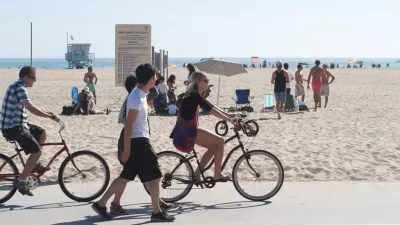After years of lower-than-normal population growth, more foreign immigrants are coming to California. The new residents contributed to a 332,000 increase in the state's population, the largest in nearly a decade, says the Calif. Dept. of Finance.
"The estimated population rose 0.88%, exceeding 38.2 million as of July. Most of that growth was 'natural increase' — births minus deaths. But those numbers stayed roughly the same as in recent years, while immigration has increased," writes Emily Alpert Reyes.
The California Department of Finance considered the growth "slow", but called it "the fastest that California has seen since 2003-04, well before the recession," Reyes adds. What's made the difference is the 170,000 net immigrants to the state between July 2012 and July 2013
To be sure, one thing hasn't changed: more Californians are leaving the state than migrating here from other states - 103,000 in all.
The one region where more migrants moved in than out is the high-priced Bay Area, reports the Mercury News' Julia Prodis Sulek in the Contra Costa Times, calling it "another sign of the tech industry's rebound and the creation of more jobs here." However, that population gain didn't hold throughout the greater region.
Domestic migration within the Bay Area has bounced for the last few years and is now in positive territory, with some 4,800 more people moving in than moving out. While Alameda, Contra Costa, Marin, Napa and Santa Cruz counties enjoyed gains during the 12-month period, the two main employments hubs of the Bay Area -- Santa Clara and San Francisco counties -- saw 3,522 and 1,824 residents, respectively, move away. Just over 1,900 people left San Mateo County.
California's population grew by roughly 332,000 people in the last fiscal year — its biggest increase in nearly a decade, according to new California Department of Finance estimates.
The Dept. of Finance now projects [PDF] that the state "will cross the 50 million mark in 2049 and grow to nearly 52.7 million by 2060." Last year we posted here that a USC study put the 50 million threshold at 2046.
FULL STORY: California population grows by 332,000 to 38.2 million

Planetizen Federal Action Tracker
A weekly monitor of how Trump’s orders and actions are impacting planners and planning in America.

Maui's Vacation Rental Debate Turns Ugly
Verbal attacks, misinformation campaigns and fistfights plague a high-stakes debate to convert thousands of vacation rentals into long-term housing.

San Francisco Suspends Traffic Calming Amidst Record Deaths
Citing “a challenging fiscal landscape,” the city will cease the program on the heels of 42 traffic deaths, including 24 pedestrians.

Defunct Pittsburgh Power Plant to Become Residential Tower
A decommissioned steam heat plant will be redeveloped into almost 100 affordable housing units.

Trump Prompts Restructuring of Transportation Research Board in “Unprecedented Overreach”
The TRB has eliminated more than half of its committees including those focused on climate, equity, and cities.

Amtrak Rolls Out New Orleans to Alabama “Mardi Gras” Train
The new service will operate morning and evening departures between Mobile and New Orleans.
Urban Design for Planners 1: Software Tools
This six-course series explores essential urban design concepts using open source software and equips planners with the tools they need to participate fully in the urban design process.
Planning for Universal Design
Learn the tools for implementing Universal Design in planning regulations.
Heyer Gruel & Associates PA
JM Goldson LLC
Custer County Colorado
City of Camden Redevelopment Agency
City of Astoria
Transportation Research & Education Center (TREC) at Portland State University
Jefferson Parish Government
Camden Redevelopment Agency
City of Claremont





























